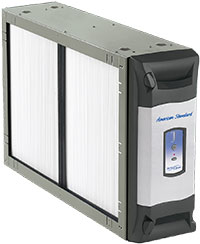
Incoming Dry Bulb Temperature
Dry bulb temperature is the temperature that the thermostat sees. Incoming dry bulb temperature is the temperature of the air at the return air register. This is our starting part for measuring the performance of your furnace and your air conditioner.
Incoming Wet Bulb Temperature
Wet bulb temperature is a combination of dry bulb temperature (sensible heat) and moisture. It is the temperature that is the lowest that evaporation will take place. It a requirement for proper Freon charging and system performance on the air conditioner side. This is also known as latent heat. This measurement is taken at the return air register and lets us know the heat value of the air entering the system to be conditioned.
Outgoing Dry Bulb Temperature
Outgoing dry bulb temperature (sensible heat) is taken at a number of supply registers in different parts of your home. This lets us know the temperature difference between the return dry bulb and the supply dry bulb.
With your furnace on, to little a temperature rise means the furnace is moving too much air or the gas burners are not burning up to potential. Too great a temperature rise means not enough airflow is filtering through the furnace and you have a potential for furnace melt down.
With your air conditioner running we are measuring temperature drop. To little temperature difference means that you have too much airflow or a poorly operating air conditioner. If the temperature difference is to great it usually means that not enough airflow is traveling thought he evaporator coil robbing your air conditioner of btu ouput.
Outgoing Wet Bulb Temperature
With your air conditioner running one of the most important and often overlooked diagnostic temperatures is the wet bulb (latent heat) temperature of the supply air. The most important feature of air conditioning is to first remove moisture from the air and as moisture in the air is removed the temperature drops comfortably. If the moisture is not removed from the air, as in an air conditioner that is way too large and expensive to operate, the air feels damp and sticky, almost a sickly cold. Once we have the wet bulb temperature differential we can convert these measurements to Enthalpy and then calculate out the btus your system is actually producing.
Enthalpy
Enthalpy is the measurement of total energy in your air. It is the combination of moisture removal and heat removal and without it a HVAC service technician can be blinded as to the problems and solutions at hand. |






